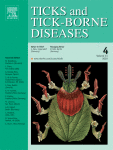Ver ítem
- xmlui.general.dspace_homeCentros Regionales y EEAsCentro Regional Santa FeEEA RafaelaArtículos científicosxmlui.ArtifactBrowser.ItemViewer.trail
- Inicio
- Centros Regionales y EEAs
- Centro Regional Santa Fe
- EEA Rafaela
- Artículos científicos
- Ver ítem
Development and field evaluation of a nested polymerase chain reaction-restriction fragment length polymorphism (nPCR-RFLP) analysis to identify A. marginale-infected and A. centrale-vaccinated cattle
Resumen
A nested polymerase chain reaction-restriction fragment length polymorphism (nPCR-RFLP) assay based on the amplification of the Anaplasma spp. highly conserved msp5 gene and posterior digestion with HindIII endonuclease was developed and evaluated in field samples. Results were compared using an nPCR specific for Anaplasma marginale (nPCR-Am) based on the msp1β gene and an nPCR specific for A. centrale (nPCR-Ac) based on the msp2 operon (msp2-o) gene.
[ver mas...]
A nested polymerase chain reaction-restriction fragment length polymorphism (nPCR-RFLP) assay based on the amplification of the Anaplasma spp. highly conserved msp5 gene and posterior digestion with HindIII endonuclease was developed and evaluated in field samples. Results were compared using an nPCR specific for Anaplasma marginale (nPCR-Am) based on the msp1β gene and an nPCR specific for A. centrale (nPCR-Ac) based on the msp2 operon (msp2-o) gene. Amplicons dilutions of msp1β and msp5 of A. marginale and msp2-o and msp5 of A. centrale and dilutions of parasited erythrocytes (PE) with A. marginale and A. centrale were used to determine the detection limits. The results were 20 DNA copies/reaction and 30 PE for A. marginale and A. centrale by nPCR-RLFP and nPCR-Am/Ac. A mix of msp5-Am and msp5-Ac was used to evaluate the interference of msp5 from one species for the detection of the other. Co-amplification of the DNA from both species was observed up to a 1:7 ratio of one species to the other. Field samples positive for Anaplasma spp. antibodies (n = 260) from 32 herds were evaluated. Strength of agreement between results by nPCR-RFLP and nPCR-Am or nPCR-Ac was 78% (κ = 0.44) and 94% (κ = 0.85), respectively. Thirty-four samples were positive for A. marginale by nPCR-RFLP but negative by nPCR-Am. msp1β amplicons of 10 samples from 5 herds with discrepancies between nPCR-Am and nPCR-RFLP results were cloned and sequenced. The analysis of the msp1β sequence showed several mutations in the target region of the internal forward primer that would explain the failure in the amplification. Only 10 of the 20 coinfections identified by nPCR-Ac/nPCR-Am were detected by nPCR-RFLP. nPCR-RFLP is a sensitive, low-cost and accessible molecular method for low-complexity laboratories. More studies are needed to establish in which circumstances coinfections can be underestimated.
[Cerrar]

Fuente
Ticks and Tick-borne Diseases 13 (4) : 101952 (July 2022)
Fecha
2022-07
Editorial
Elsevier
ISSN
1877-959X
Formato
pdf
Tipo de documento
artículo
Palabras Claves
Derechos de acceso
Embargado
 Excepto donde se diga explicitamente, este item se publica bajo la siguiente descripción: Creative Commons Attribution-NonCommercial-ShareAlike 2.5 Unported (CC BY-NC-SA 2.5)
Excepto donde se diga explicitamente, este item se publica bajo la siguiente descripción: Creative Commons Attribution-NonCommercial-ShareAlike 2.5 Unported (CC BY-NC-SA 2.5)

